Trust, as a key factor in unlocking the potential of data in the digital economy, is an increasingly central element in all data regulations. The European General Data Protection Regulation, in 2016 already recognised that if individuals have more control over their own personal data, this will improve trust and contribute to the positive impact on the development of the digital economy. The European Commission's European Data Law 2022 European Commission proposal puts even greater emphasis on the targets themselves, stating that "low trust prevents the full potential of data-driven innovation from being realised".
Among the findings of the World Data Regulation Survey published by the World Bank in 2021, highlights the need to strengthen regulatory frameworks around the world to build greater citizen trust. This would contribute to more effective effectiveness of government initiatives that use data and that aim, in many cases, to generate value forsociety. As an example, he cites the limited impact of contact-tracking applications around the world during the COVID-19 pandemic, largely due to a lack of public confidence in the potential use of the data provided.
If we really believe that trust in data is so critical to creating value for society and the economy, we need to pay close attention both to the mechanisms we have at our disposal to enhance that trustworthiness, and to the strategies for building and maintaining that trust, beyond the regulatory frameworks themselves.
Quality and transparency
Trust in data starts with quality and transparency. When users understand how data are collected, processed and maintained, they are more likely to trust them to use them use it, and even be more willing to contribute their own data.
A fundamental mechanism for ensuring quality and transparency is the implementation of rigorous standards, such as the UNE specifications for Data Governance UNE 0077:2023, Data Management UNE 0078:2023, and Data Quality Management UNE 0079:2023 at each stage of the data lifecycle. On the one hand, quality is enhanced through the deployment of robust validation and verification practices that ensure the accuracy and integrity of the data, and on the other hand, transparency is improved through, for example, descriptive metadata that provide detailed information about the data, including its origin, collection methodology and any transformation it has undergone.
European Data Spaces
The European Data Spaces is an ambitious EU initiative aimed at building trust and facilitating the exchange and use of data between countries and sectors in a secure and regulated environment. The central idea behind the European Data Spaces is to create environments in which the availability, accessibility and interoperability of data are maximised, while the risks associated with data handling are minimised. Initially the European data strategy initially envisaged 10 data spaces in strategic areas such as health, energy or public administration. Since then this number has grown and other data spaces have been launched in important areas such as media and cultural heritage, or in strategic sectors for Spain such as tourism.
In order to bet on the leadership in data spaces in strategic sectors for Spain, the government is promoting the Gaia-X Spanish Hub the Spanish government is promoting a new initiative, comprised of companies of all sizes, aimed at deploying a solid ecosystem in the field of industrial data sharing
Improving cyber security
The increasing number of cyber security incidents media headlines, some of which have even brought private companies and public bodies to a standstill, has made cyber security a primary concern for users and organisations in the digital age.
Robust cyber security involves organisations deploying advanced technologies and best practices to protect systems and data from unauthorised access and malicious manipulation through measures such as firewalls, two-factor authentication, and real-time threat monitoring and detection, encryption two-factor authentication, and real-time threat monitoring and detection. However, improving users' education and cybersecurity awareness is also vital to help them recognise and avoid potential threats.
European digital identity
The European Digital Identity is being developed in the framework of the European Union with the aim of providing citizens and businesses with a secure and unified way of accessing services, public and private, online and offline, across the EU. The idea is that, with a European digital identity, people would be able to identify themselves or confirm data in services such as banking, education or health, among others, in a secure and frictionless way, providing a high level of security and privacy protection.
This deepens the framework of trust and confidence created by the EIDAS Regulation on electronic identification and trust services for electronic transactions in the internal market, which already contributes significantly to increasing consumer confidence phishing or improving confidence in the origin of documents.
Building a culture of trust and responsibility in the handling of data and digital infrastructures is the focus of the actions of EU governments, including Spain. In this context, the intersection between data quality and transparency, robust cybersecurity that reduces cybercrime, European Data Spaces, and European digital identity stand out as key mechanisms to cultivate this trust and propose a route towards greater innovation that ultimately generates social and economic value through data.
Contenido elaborado por Jose Luis Marín, Senior Consultant in Data, Strategy, Innovation & Digitalization. Los contenidos y los puntos de vista reflejados en esta publicación son responsabilidad exclusiva de su autor.
Public administration is working to ensure access to open data, in order to empowering citizens in their right to information. Aligned with this objective, the European open data portal (data.europa.eu) references a large volume of data on a variety of topics.
However, although the data belong to different information domains or are in different formats, it is complex to exploit them together to maximise their value. One way to achieve this is through the use of RDF (Resource Description Framework), a data model that enables semantic interoperability of data on the web, standardised by the W3C, and highlighted in the FAIR principles. RDF occupies one of the top levels of the five-star schema for open data publishing, proposed by Tim Berners-Lee, the father of the web.
In RDF, data and metadata are automatically interconnected, generating a network of Linked Open Data (LOD) by providing the necessary semantic context through explicit relationships between data from different sources to facilitate their interconnection. This model maximises the exploitation potential of linked data.
It is a data sharing paradigm that is particularly relevant within the EU data space initiative explained in this post.
RDF offers great advantages to the community. However, in order to maximise the exploitation of linked open data it is necessary to know the SPARQL query language, a technical requirement that can hinder public access to the data.
An example of the use of RDF is the open data catalogues available on portals such as datos.gob.es or data.europa.eu that are developed following the DCAT standard, which is an RDF data model to facilitate their interconnection. These portals have interfaces to configure queries in SPARQL language and retrieve the metadata of the available datasets.
A new app to make interlinked data accessible: Vinalod.
Faced with this situation and with the aim of facilitating access to linked data, Teresa Barrueco, a data scientist and visualisation specialist who participated in the 2018 EU Datathon, the EU competition to promote the design of digital solutions and services related to open data, developed an application together with the European Publications Office.
The result is a tool for exploring LOD without having to be familiar with SPARQL syntax, called Vinalod: Visualisation and navigation of linked open data. The application, as its name suggests, allows you to navigate and visualise data structures in knowledge graphs that represent data objects linked to each other through the use of vocabularies that represent the existing relationships between them. Thus, through a visual and intuitive interaction, the user can access different data sources:
- EU Vocabularies. EU reference data containing, among others, information from Digital Europa Thesaurus, NUTS classification (hierarchical system to divide the economic territory of the EU) and controlled vocabularies from the Named Authority Lists.
- Who's Who in the EU. Official EU directory to identify the institutions that make up the structure of the European administration.
- EU Data. Sets and visualisations of data published on the EU open data portal that can be browsed according to origin and subject.
- EU publications. Reports published by the European Union classified according to their subject matter.
- EU legislation. EU Treaties and their classification.
The good news is that the BETA version of Vinalod is now available for use, an advance that allows for temporary filtering of datasets by country or language.
To test the tool, we tried searching for data catalogues published in Spanish, which have been modified in the last three months. The response of the tool is as follows:

And it can be interpreted as follows:

Therefore, the data.europa.eu portal hosts ("has catalog") several catalogues that meet the defined criteria: they are in Spanish language and have been published in the last three months. The user can drill down into each node ("to") and find out which datasets are published in each portal.
In the example above, we have explored the 'EU data' section. However, we could do a similar exercise with any of the other sections. These are: EU Vocabularies; Who's Who in the EU; EU Publications and EU Legislation.
All of these sections are interrelated, that means, a user can start by browsing the 'EU Facts', as in the example above, and end up in 'Who's Who in the EU' with the directory of European public officials.

As can be deduced from the above tests, browsing Vinalod is a practical exercise in itself that we encourage all users interested in the management, exploitation and reuse of open data to try out.
To this end, in this link we link the BETA version of the tool that contributes to making open data more accessible without the need to know SPARQL, which means that anyone with minimal technical knowledge can work with the linked open data.
This is a valuable contribution to the community of developers and reusers of open data because it is a resource that can be accessed by any user profile, regardless of their technical background. In short, Vinalod is a tool that empowers citizens, respects their right to information and contributes to the further opening of open data.
Updated: 21/03/2024
On January 2023, the European Commission published a list of high-value datasets that public sector bodies must make available to the public within a maximum of 16 months. The main objective of establishing the list of high-value datasets was to ensure that public data with the highest socio-economic potential are made available for re-use with minimal legal and technical restriction, and at no cost. Among these public sector datasets, some, such as meteorological or air quality data, are particularly interesting for developers and creators of services such as apps or websites, which bring added value and important benefits for society, the environment or the economy.
The publication of the Regulation has been accompanied by frequently asked questions to help public bodies understand the benefit of HVDS (High Value Datasets) for society and the economy, as well as to explain some aspects of the obligatory nature of HVDS (High Value Datasets) and the support for publication.
In line with this proposal, Executive Vice-President for a Digitally Ready Europe, Margrethe Vestager, stated the following in the press release issued by the European Commission:
"Making high-value datasets available to the public will benefit both the economy and society, for example by helping to combat climate change, reducing urban air pollution and improving transport infrastructure. This is a practical step towards the success of the Digital Decade and building a more prosperous digital future".
In parallel, Internal Market Commissioner Thierry Breton also added the following words on the announcement of the list of high-value data: "Data is a cornerstone of our industrial competitiveness in the EU. With the new list of high-value datasets we are unlocking a wealth of public data for the benefit of all”. Start-ups and SMEs will be able to use this to develop new innovative products and solutions to improve the lives of citizens in the EU and around the world.
Six categories to bring together new high-value datasets
The regulation is thus created under the umbrella of the European Open Data Directive, which defines six categories to differentiate the new high-value datasets requested:
- Geospatial
- Earth observation and environmental
- Meteorological
- Statistical
- Business
- Mobility
However, as stated in the European Commission's press release, this thematic range could be extended at a later stage depending on technological and market developments. Thus, the datasets will be available in machine-readable format, via an application programming interface (API) and, if relevant, also with a bulk download option.
In addition, the reuse of datasets such as mobility or building geolocation data can expand the business opportunities available for sectors such as logistics or transport. In parallel, weather observation, radar, air quality or soil pollution data can also support research and digital innovation, as well as policy making in the fight against climate change.
Ultimately, greater availability of data, especially high-value data, has the potential to boost entrepreneurship as these datasets can be an important resource for SMEs to develop new digital products and services, which in turn can also attract new investors.
Find out more in this infographic:

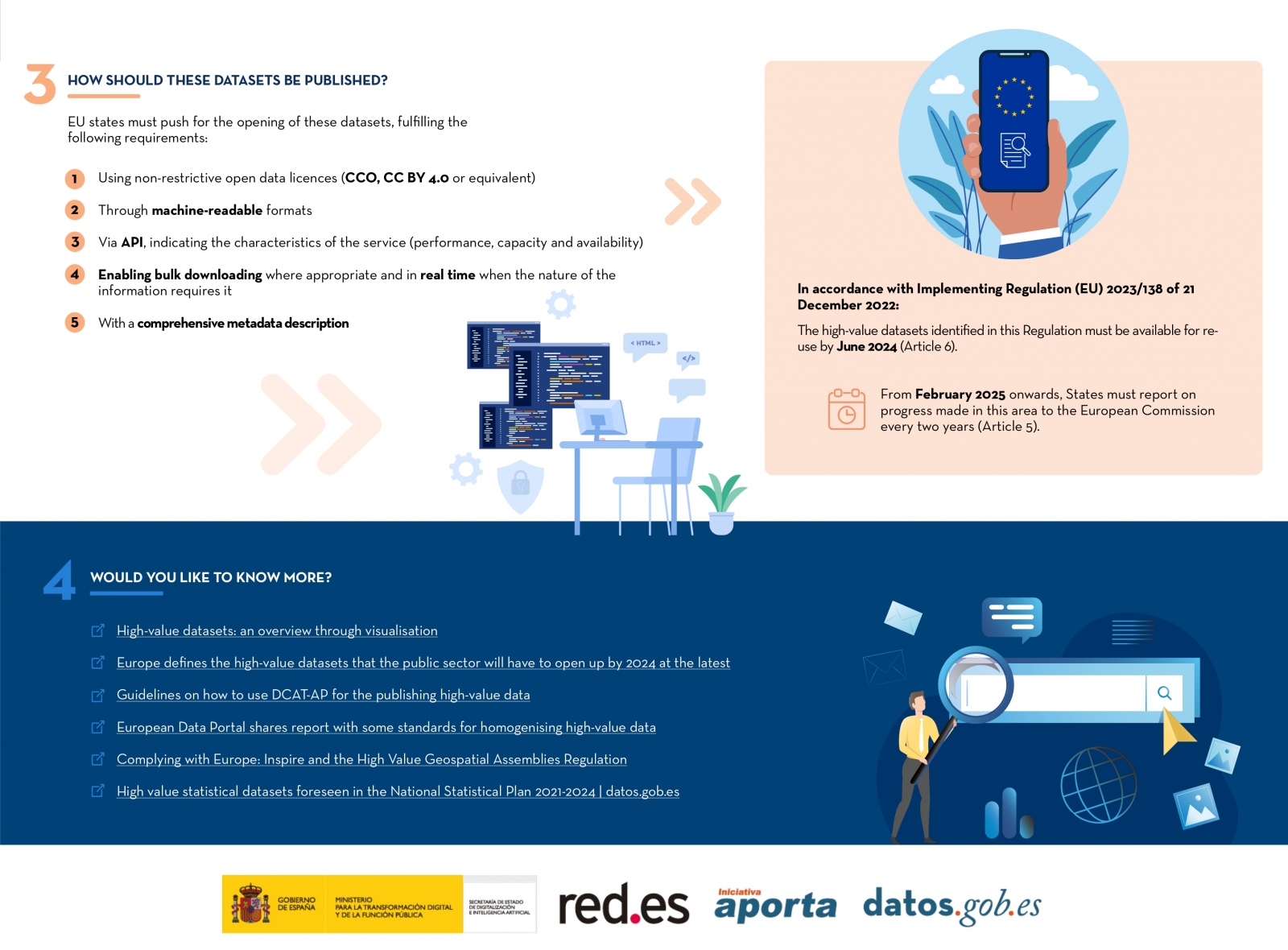
Access the accessible version on two pages.
After several months competing, on 20 October the open data contest organised by the EU came to an end. The EU Datathon is a contest that gives data developers and scientists the chance to demonstrate, through their creativity, the potential of open data.
Although in this post you can find out in detail about the winning projects, in this case we would like to highlight the participation of two Spanish developers whose initiatives were chosen as semi-finalists from amongst the 156 proposals submitted at the start.
In an edition that broke the attendance records, both in terms of the number of contestants and the countries of origin, Antonio Moneo and Manuel Jose García represented Spain with two projects which stood out for their innovative nature regarding the reuse of open data.
Using Artificial Intelligence to optimally solve public tenders
Manuel José García has a PhD in Telecommunications Engineering from the University of Oviedo and currently works as a data scientist at the technology consultancy NTT Data. After scooping up first prize in the Euskadi Open Data contest in 2020, García decided to take part in the European hackathon, making the most of what he had learned from the research carried out in his PhD thesis and which gave rise to the project 'Detection of irregular tenders in Spain through big data analytics and artificial intelligence'.
"It is an initiative that uses Big Data and Artificial Intelligence (AI) to analyse the data from public tenders and to automatically recommend those companies that can best undertake the tender. With this in mind, a search engine is created for companies that can carry out a tender and a form is filled out describing the details that characterise the public tender. From that point onwards, the programme seeks the most suitable companies to carry out the project”, describes Manuel Jose García, who adds that the list of companies recommended by tender is achieved thanks to the fact that the AI model has been trained with the history of hundreds of thousands of tenders and winning companies from the past, learning what type of companies win tenders and what characteristics they have.
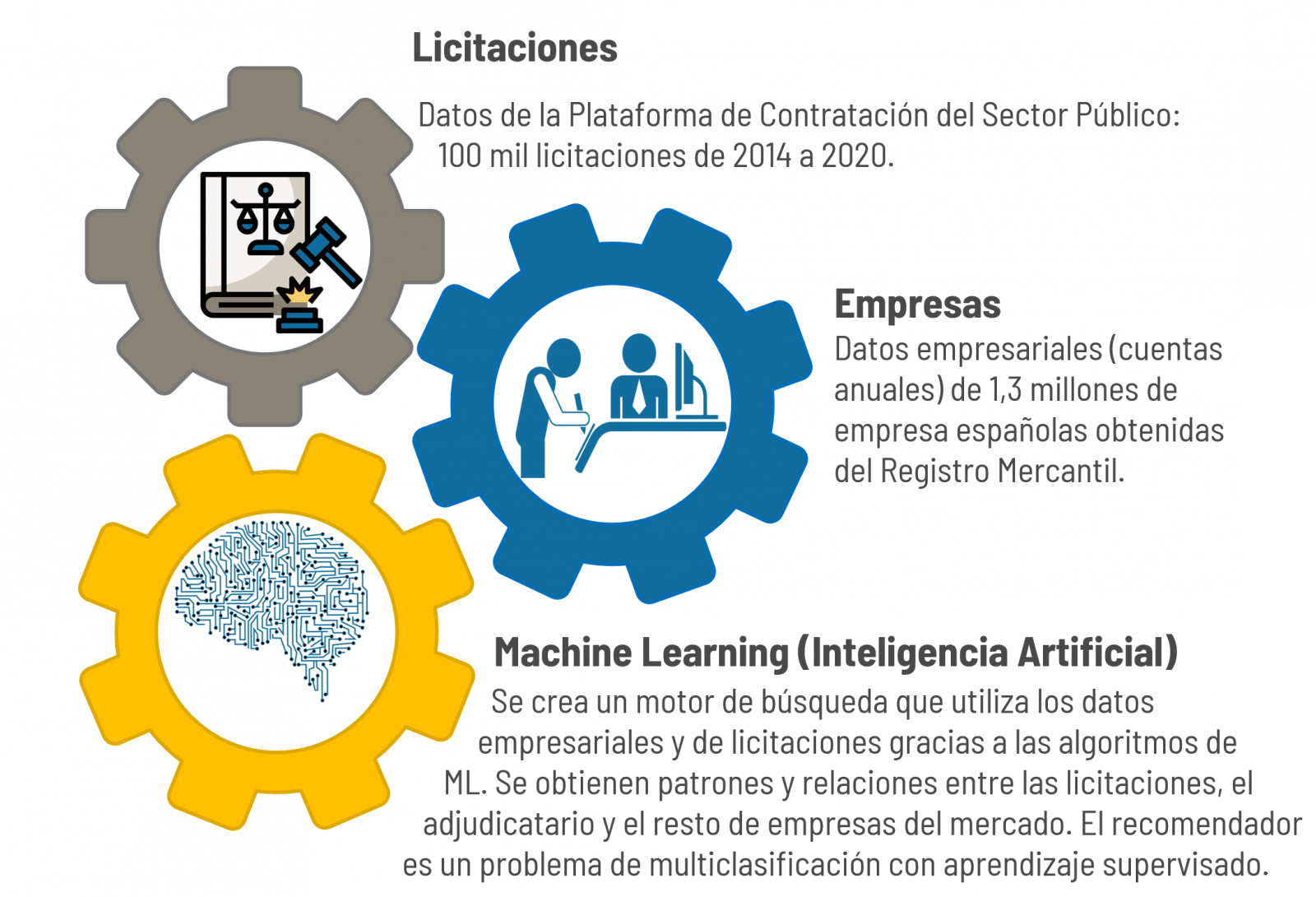
An essential requirement in order to participate in the European datathon is to use information from the data catalogues that both Europe and Spain make available to the public at a national, regional and local level. In the specific case of Manuel José García, his project has been developed using the public tender data available at the Public Procurement Platforms.
“The project has been developed using two types of data sources. On the one hand, the public and free data of the tenders and, on the other, the business data required to search for and characterise the companies present in the search engine. In particular, the annual accounts that companies must submit to the Registrar of Companies have been used. These data are public but paid and it is vogue to make them free as they are data managed by a public entity”, comments the data scientist.
In fact, it is precisely this point related with the data from the Registrar of Companies which entailed a challenge to take the project forward: “Getting structured data from public tenders is complicated, since the open data format of the Spanish Procurement Platform is difficult to handle. In addition, it is necessary to carry out thorough cleaning of the data because their quality is low”, he points out.
In his opinion, if public administrations wish to promote the reuse of open data, “They must promote the culture of data. In other words, to be aware of the importance of the data they handle and store and, in turn, be proactive to exploit said data and make them available to third parties”.
Architecture and open data to make the Sustainable Development Goals visible
In addition to being the Director of Change Management and Advanced Analysis at BBVA, Antonio Moneo was also a semi-finalist in the latest edition of the European datathon thanks to a project that merges art with the dissemination of open data.
“Tangible Data is an initiative whose goal is to convert emblematic data series into physical sculptures and thereby be able to lend visibility to issues such as climate change, inequality or the transparency of our governments. Against a backdrop of excess information and a growing digital divide, it is essential to rely on the physical environment to explain what is happening in the world", explains Antonio Moneo and he stresses that "representing data in a sculpture allows us to present a challenge from an objective, respectful perspective”.

When selecting the open data sets, Moneo was clear that he wanted to make visible the realities and statistics related with the Sustainable Development Objectives so that his project would fulfil the social purpose that led him to participate in the datathon: “We use open data from reliable sources and properly licensed with Creative Commons or MIT criteria. Sometimes we have used a private data source, but our objective is to enhance the information that is already available. In addition, we usually use the data in the manner in which they are published and only apply some transformations such as the smoothing of the curves with moving averages that allow us to make the sculptures more pleasant to the touch and, self-evidently, techniques to create volumes in three dimensions that are the basis for the sculptures," he observed.
Hence, to carry out Tangible Data it has been necessary, on the one hand, to build a physical structure and, on the other, to make it invite the user to move to the digital realm where, at the end of the day, the information they seek to make visible can be found. “The first step is to design a 3D model in virtual format which we send off to be produced locally, using the FabLabs network. Later, we include a QR code in the sculpture that allows the audience to know in depth the meaning of the data that it reflects”, explained the promoter of the project.
Developing such an ambitious project, both from a physical point of view and from an informative perspective, is no easy task. The thing is, it is not only a matter of circumventing the design of the sculpture as such, but also of finding the necessary data to transfer the reality that it is sought to represent: “Comparability is one of the biggest challenges we have encountered because, in many cases, the most relevant data for measuring the environment are not always comparable. Sometimes we find data at a regional level, sometimes at a national or local level, but it is not always possible to find all the information you need. This is why, in order to solve this challenge, we have invested more time in searching for data and, in many cases, the initial idea about a sculpture has been modified because we could not find data of sufficient quality”, he went on to say.
Moneo also commented that the other major difficulty that has marked the development of the project has been to access updated data. “Updating is always a critical issue, but right now it is even more so. The consequences of COVID, the war in Ukraine and the current energy crisis paint a very different world from the one we encountered in 2015, when the sustainable development objectives were signed. For example, it is estimated that as a consequence of the pandemic, between 70 and 150 million people will fall into the extreme poverty segment (with less than 1.9 dollars a day). This change, bucking the trend of the last three decades, is not reflected in the World Bank statistics yet as they only go up to 2019. It would this seem that that very relevant data reflect a distorted reality”, he concluded.
A positive review of his time in the EU Datathon
Despite not having reached the final that would have allowed them to compete for part of the total prize, which amounted to 200,000 euros, the two participants agreed that their experience in the datathon has been more than positive. So, whilst Manuel José García believes that "the European Commission must continue to commit to these initiatives so that people are aware of the value of data and the challenges that they can solve”, for his part, Antonio Moneo points out that “this type of action motivates the agencies that drive the data and those who are developing to improve the impact of data on society”.
What's more, both participants have managed to stimulate their professional curiosity thanks to this challenge, whilst simultaneously testing the potential and quality of their respective work vis-à-vis European data experts.
Like every other year, the EU Open Data Portal has just published the results of its report Open Data Maturity 2022. It is a study that assesses the maturity of European countries in the field of open data and it provides an overview of the good practices followed in Europe, which can be transferred to other national and local contexts. Both the member states of the European Union (EU-27) and other countries in the region have participated in the study.
Spain has achieved a score of 92%, thirteen points above the EU27 average. With this score, it is in the leading group. France secured first place, followed by Ukraine and Poland.
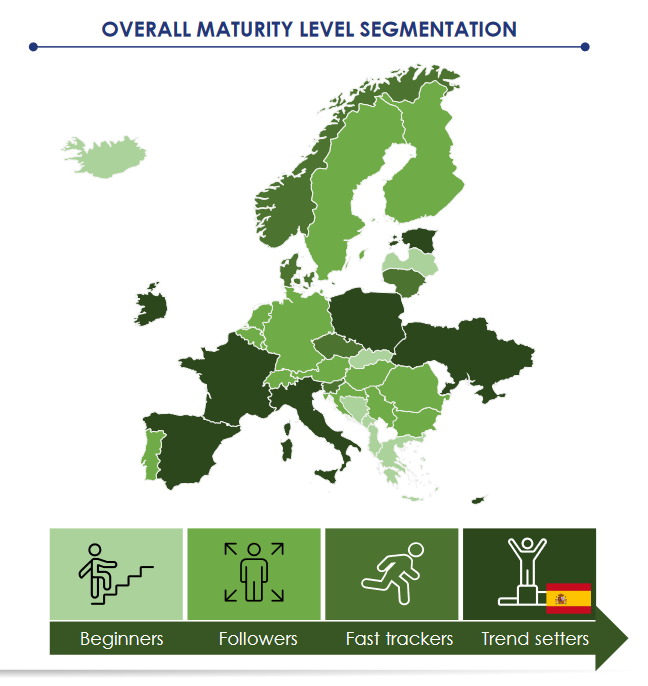
Spain is above the European average for the 4 indicators analysed
The report measures maturity in relation to four aspects of open data:
- Policy, focused on the open data strategies of the different countries.
- Impact, which analyses the activities carried out to monitor and measure the reuse of open data and their impact.
- Portal, focused on evaluating the functions and characteristics of the national platform that allows users to access open data and promote interaction within the community.
- Quality, which examines mechanisms to ensure the quality of (meta)data.
In all four categories, Spain is ahead of the EU27 average, particularly standing out in the policy section. Some of the aspects that the report highlights in Spain are the open mechanisms for communicating and interacting from datos.gob.es with the open data community, the use of dashboards to monitor the use of datasets or some specific examples of use cases such as Climate change scenario viewer or Gijón in a click.
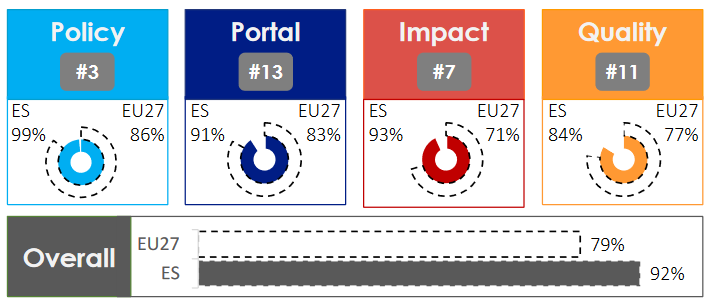
With this score, Spain falls within the so-called trendsetter group. The countries that belong to this group stand out for their strong commitment to open data, borne out by an advanced strategy, more mature platforms and an active methodology for measuring the impact of open data.

3 key trends in Europe
This year's analysis highlights three trends at European level:
- EU Member States are preparing for the implementation of the high-value datasets regulation. Directive 2019/1024 highlighted, amongst other issues, a specific regime for the so-called high-value data, in other words, those whose reuse is associated with considerable benefits for society, the environment and the economy. Although their implementing regulation has not yet been made public, 96% of EU Member States are already working on the identification of high-value data, especially in the categories of statistical, geospatial, Earth observation, environmental and meteorological data. In addition, 85% are already prepared to monitor and measure their level of reuse and 63% to ensure their interoperability with available data sets from other countries. Spain is no exception and it is one of the most advanced countries in this regard.
- Measuring the impact of open data is a priority for EU Member States, but it is a major challenge too. Countries are still interested in understanding and capturing open data reuse and value creation, but compiling data on the impact created remains challenging, especially in the economic area.
- In a post-pandemic world, European countries face new and old common challenges. The impact of the war in Ukraine has affected all countries, both socially and economically. Open data have proven to serve as a mechanism to help refugees or improve energy management. Other common challenges highlighted in the report are the lack of resources and qualified personnel or the difficulty in coordinating between the different levels of the administration, inter alia.
Recommendations to keep moving ahead in the field of open data
The report ends with a series of recommendations by groups of countries. In the case of open data trendsetters, the group to which Spain belongs, the report recommends focusing on maintaining the current ecosystem, experimenting and sharing knowledge.
To be precise, the focus should be placed on improving and consolidating open data ecosystems through the development of thematic communities of providers and reusers. It is also recommended to collaborate with data.europa.eu, other national data teams, universities and research institutions to develop an experimental impact evaluation framework.
High-value data sets stand out as one of the areas to prioritise, based on that which was previously indicated in Directive 2019/1024. In addition to preparing for the Data Governance Regulation, evaluating the existing options to expand the portals and assuming the role of public registry for those organisations linked to the altruistic transfer of data.
You can read the full report via this link.
The European Directive 2019/1024 on open data and re-use of public sector information emphasises, among many other aspects, the importance of publishing data in real time. In fact, the document talks about dynamic data, which it defines as "documents in digital format, subject to frequent or real-time updates due to their volatility or rapid obsolescence". According to the Directive, public bodies must make this data available for re-use by citizens immediately after collection, through appropriate APIs and, where possible, as a bulk download.
To explore this further, the European Data Portal, Data.europa.eu, has published the report “Real-time data 2022: Approaches to integrating real-time data sources in data.europa.eu” which analyses the potential of real-time data. It draws on the results of a webinar held by data.europa.eu on 5 April 2022, a recording of which is available on its website.
In addition to detailing the conclusions of the event, the report provides a brief summary of the information and technologies presented at the event, which are useful for real-time data sharing.
The importance of real-time data
The report begins by explaining what real-time data are: data that are frequently updated and delivered immediately after collection, as mentioned above. These data can be of a very heterogeneous nature. The following table gives some examples:
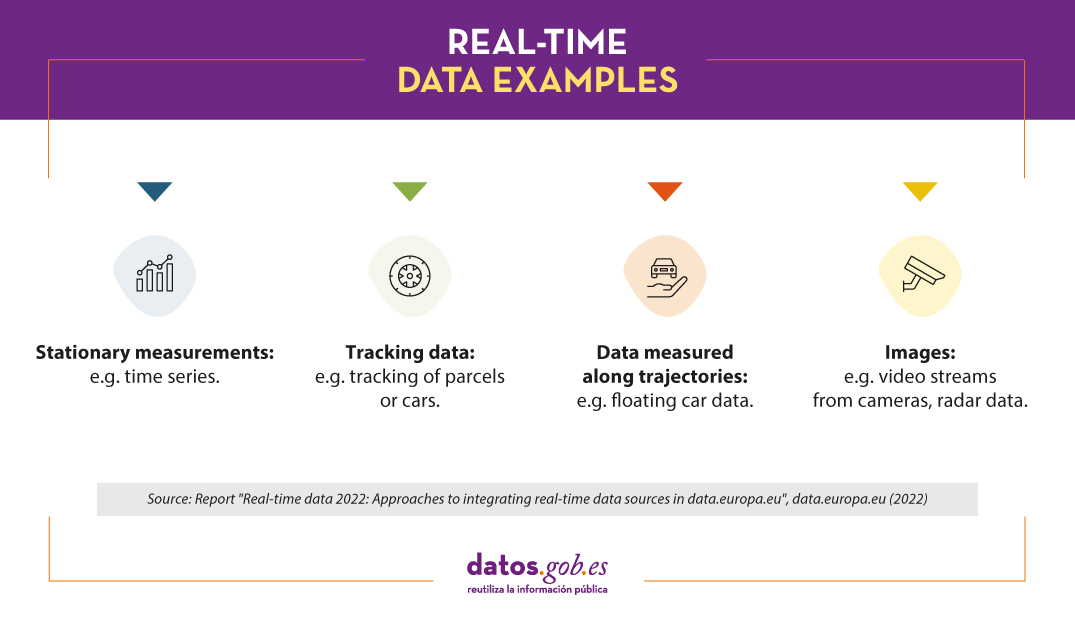
This type of data is widely used to shape applications that report traffic, energy prices, weather forecasts or flows of people in certain spaces. You can find out more about the value of real-time data in this other article.
Real-time data sharing standards
La interoperabilidad es uno de los factores más importantes a tener en cuenta a la hora de seleccionar la tecnología más adecuada para el intercambio de datos en tiempo real. Se precisa un lenguaje común, es decir, formatos de datos comunes e interfaces de acceso a datos que permitan el flujo de datos en tiempo real. Dos estándares que ya son muy utilizados en el ámbito del Internet de las cosas (IoT en sus siglas en inglés) y que pueden ayudar en este sentido son:
SensorThings API (STA)
SensorThings API, from the Open Geospatial Consortium, emerged in 2016 and has been considered a best practice for data sharing in compliance with the INSPIRE Directive.
This standard provides an open and unified framework for encoding and providing access to sensor-generated data streams. It is based on REST and JSON specifications and follows the principles of the OData (OASIS Open Data Protocol) standard.
STA provides common functionalities for creating, reading, updating and deleting sensor resources. It enables the formulation of complex queries tailored to the underlying data model, allowing more direct access to the specific data the user needs. Query options include filtering by time period, observed parameters or resource properties to reduce the volume of data downloaded. It also allows sorting the content of a result by user-specified criteria and provides direct integration with the MQTT standard, which is explained below.
Message Queuing Telemetry Transport (MQTT)
MQTT was invented by Dr. Andy Stanford-Clark of IBM and Arlen Nipper of Arcom (now Eurotech) in 1999. Like STA, it is also an OASIS standard.
The MQTT protocol allows the exchange of messages according to the publish/subscribe principle. The central element of MQTT is the use of brokers, which take incoming messages from publishers and distribute them to all users who have a subscription for that type of data. In this type of environment, data is organised by topics, which are freely defined and allow messages to be grouped into thematic channels to which users subscribe.
The advantages of this system include reduced latency, simplicity and agility, which facilitates its implementation and use in constrained environments (e.g. with limited bandwidth or connectivity).
In the case of the European portal, users can already find real-time datasets based on MQTT. However, there is not yet a common approach to providing metadata on brokers and the topics they offer, and work is still ongoing.
Other conclusions of the report
As mentioned at the beginning, the webinar on 5 April also served to gather participants' views on the use of real-time data, current challenges in data availability and needs for future improvements. These views are also reflected in this report.
Among the most valued categories of real-time data, users highlighted traffic information and weather data. Data on air pollution, allergens, flood monitoring and stock market information were also mentioned. In this respect, more and more detailed data were requested, especially in the field of mobility and energy in order to be able to compare commodity prices. Users also highlighted some drawbacks in locating real-time data on the European portal, including the heterogeneity of the information, which requires the use of common standards and formats across countries.
Finally, the report provides a set of recommendations on how to improve the ability to locate real-time data sources through data.europa.eu. To this end, a series of short and medium-term actions have been established, including the collection of use cases, support for data providers and the development of best practices to unify metadata.
You can read the full report here.
What role can data portals play in the context of the data spaces identified in the European Data Strategy? This is the question posed by the European Commission, through its open data initiative 'data.europa.eu', and which serves as the starting point for the report "data.europa.eu and the European common data spaces".
Data.europa.eu and the Common European Data Spaces: Report Methodology
"data.europa.eu and the European common data spaces" is the first of two reports analysing the role that data.europa.eu could play in the context of the emerging European Union common data spaces envisaged in the European Data Strategy. It should be noted that part of this strategy is the development of interoperable common European data spaces across different sectors, an initiative that is still in the process of consolidation.
The objective of the report is twofold. On the one hand, it seeks to identify open data holders who are involved in ongoing implementations of data spaces. On the other hand, it offers a reflection on the role that open data portals could play in these implementations, especially the European portal.
To carry out the development of this first report, its authors (Óscar Corcho and Elena Simperl), conducted an in-depth analysis of the existing official documentation on the European Data Strategy, as well as reviewing online resources and use cases of initiatives such as IDSA, Gaia-X or Open DEI.
Simultaneously, they conducted interviews with developers of data architectures and data spaces. As full implementations do not yet exist, the analysis was based on use cases, work in progress and roadmaps, rather than on operational data spaces.
Main findings of the report
Although this is only the first of two studies, the authors have been able to highlight several far-reaching conclusions:
- Open data is commonly mentioned alongside private and personal data as a type of data source. However, open data owners are often not involved in initiatives to develop reference data space architectures or their implementations. This situation needs to change by ensuring their involvement.
- Open data holders have extensive experience in data publishing, metadata management, quality indicators, dataset discovery and federation, as well as in technologies and standards such as DCAT. However, there is very little transfer of knowledge and technologies from the open data community to the data space community.
- The use of data from multiple sources requires interoperability at various levels. The need for data intermediaries acting as neutral brokers to ensure interoperability is an under-explored issue in the context of data spaces. Public administrations, building on their experience in data publishing, are best placed to take on this role.
The second report - to be published once the data space implementations are available in 2023 - will explore three data space scenarios, with data.europa.eu as data holder or data broker. In addition, it will analyse in detail the challenges and opportunities for the European portal in the context of these developments.
A webinar to further explore the role of the European Data Portal in data spaces
The concept of "data space" arises from the need to provide as much openness of information as possible, while recognising that some data should not be completely open. As a result of this dichotomy, the idea of creating a community of participants who share and use data on the basis of pre-established rules, guaranteeing an environment of sovereignty and trust, was born.
Ideas such as these prompted a webinar on open data and how it fits into broader data space ecosystems to be held on 4 May in the framework of the data.europa.academy. During this session in English, which you can access via this link, some key points of the report's analysis were explored in more detail. In addition to the recording of the session, you can view and download for free the PDF presentation that was used as a guide for the webinar.
Next steps
Ultimately, data spaces belong to an emerging field that still has some biases and limitations. Open government data sources, portals and their practitioners are not as well represented as they could be, even in sectors where they play a key role, such as mobility or smart cities. This needs to change.
The future of the research conducted in this report is to await the publication of the aforementioned second report, which will become effective once more developed European common data spaces are available and the work on reference resources has been completed by IDSA and Gaia-X. These forthcoming actions will allow the formulation of more specific recommendations that can be based on the characteristics of the actual data spaces in operation.
For the seventh consecutive year, the European Data Portal has presented its Open Data Maturity assessment. This is a report that analyses a series of indicators to measure the maturity of open data across Europe, in order to understand the progress of each country, make comparisons and find areas for improvement.
This year, Spain ranks third with a score of 95%, 14 points above the European average (81%). First place goes to France (98%), followed by Ireland (also with 95%).
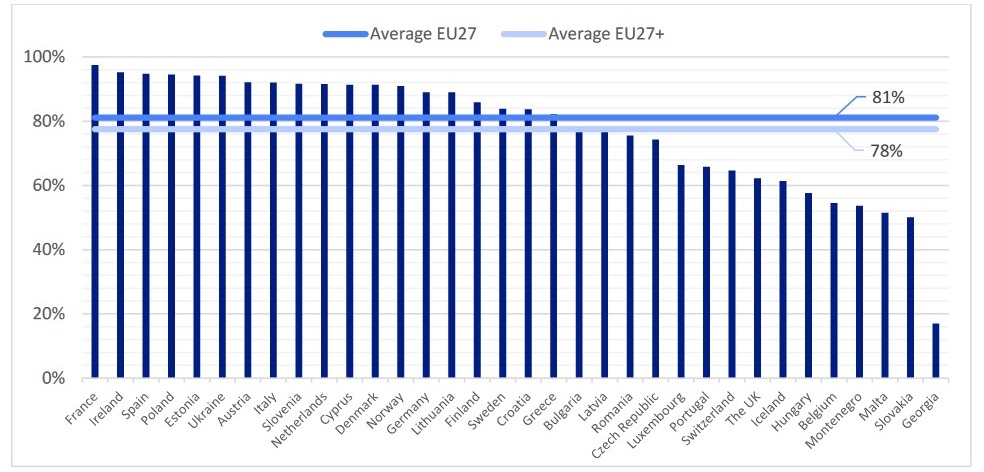
Spain, above the European average in all the analyzed categories
As every year, the report measures 4 categories:
- Policy, focusing on the existence of specific policies and strategies to promote open data at the national level.
- Impact, which analyzes activities to monitor and measure the reuse of open data.
- Portal, which evaluates the existing functions in the national platform (in the case of our country, datos.gob.es) to access open data and interact with the community.
- Quality, which studies the mechanisms that guarantee the quality of (meta)data.
Spain is ahead of Europe in all categories:
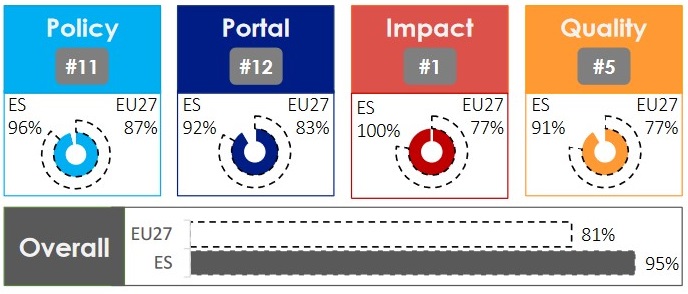
In total, Spain's score has increased by one percentage point compared to 2020, when it stood at 94%. It stands out especially in the impact category, where it is in first position with 100% of the score. The report highlights how the Aporta Initiative conducts an annual national survey to ascertain the control over the use of data by the various national, regional and local public bodies. It also highlights the collaborations that the institutions carry out with universities, such as the agreement adopted by the Valencian Government with all public universities in the Community to work together in training and research activities related to transparency and open data.
Our country continues in the group of open data prescribers
As part of the analysis, the European Portal groups all participating countries into four groups based on the assessment of open data maturity during 2021. With its score, Spain continues to place itself in the leading group of open data in Europe, called trend-setters. The group with the best results is completed by France, Ireland, Poland, Estonia and Ukraine.

These countries are characterized by an advanced open data policy and a platform with a wide range of functions to meet the needs of advanced users and publishers. They are also countries where there are initiatives to ensure the publication of high-quality data and compliance with the DCAT-AP European open data cataloging profile, and where communities around data reuse are in place. Finally, it is highlighted that there are established methodologies in place to assess the impact of data in the different domains.
Europe's average score rises
In 2021, the average score relating to open data maturity of EU27 countries is 81%, an increase of three percentage points compared to 2020.
The report highlights three trends observed in all the countries analysed:
- Member States are updating their policies to transpose the Open Data Directive into their national legislation. More and more countries are carrying out the transposition process. In the case of Spain, it was included in the Royal Decree-Law 24/2021, approved last December 2 by the Congress. It is worth mentioning that the Open Data Directive still requires the adoption of a future implementing regulation by the European Commission, where the list of high-value datasets to be provided free of charge through APIs is included.
- Understanding, monitoring and measuring the impact of open data is becoming more important. The impact dimension has seen the most growth in the last year, while the quality indicator is the least mature. In recent years, impact has been measured mainly through activities such as maintaining records of data downloads or creating lists of use cases. This year there has been a clear trend towards in-depth studies, such as desk research or surveys, to quantify and verify the impact of open data.
- The COVID-19 pandemic continues to highlight the value and impact of open data. Last year, the health situation led to highlight the importance of systematically collecting data and making it available to the public in an up-to-date manner. This year, the available data is complemented by statistics related to vaccination.
Future recommendations
The report ends with a series of recommendations for each group of countries. In the case of prescribers, a group that includes Spain, some issues are highlighted, such as continuing to develop thematic communities of providers and reusers, giving priority to the high-value data categories highlighted in the Open Data Directive. In this sense, Spain is moving forward with the creation of specific hubs for various sectors such as tourism or health.
Other examples of recommendations are to collaborate with other national and international teams to develop an experimental impact assessment framework and with academic institutions to provide advanced courses and training on open data.
The EU Publications Office has awarded a six-year contract to a consortium including the Ontology Engineering Group of the Universidad Politécnica de Madrid. The aim of the contract is to continue the development of the European Data Portal and to carry out consultancy and research work leading to the new data.europa.eu service.
data.europa.eu: a single access point for data across Europe
Until now, users wishing to locate public sector data related to Europe or member states had two platforms at their disposal:
- The European Union Open Data Portal (EUOPD), which provides access to data from the European Union institutions and other bodies for commercial or non-commercial use; and
- The European Data Portal (EDP), which federates the metadata of public sector information available in the open data portals of European countries. In the case of Spain, the datasets that the different organisations federate with datos.gob.es are automatically federated with the EDP, increasing their visibility at an international level.
The awarded contract aims, among other objectives, at the development, maintenance, operation and evolution of a pan-European data portal infrastructure combining the two current portals under the name data.europa.eu.This service is expected to act as a single point of access to open datasets made available by different publishers, including EU Member States, EU institutions, regional and local authorities, and possibly also NGOs and other international organisations. It will also integrate the EU web archive and resources with persistent URIs of EU institutions and bodies. In this way, it aims to facilitate the publication and re-use of open data across the region.
Continuing the impulse, analysis and assessment of the European open data ecosystem
The consortium's tasks will include fostering the provision of quality data and metadata, as well as promoting the re-use of public sector information across Europe. It will also continue to support the open data community through various actions such as participation in its own and third party events, the organisation of webinars and the production of news, articles and reports on open data developments, best practices and use cases.
In this sense, the consortium will continue to carry out, among others, two of the key studies that the EDP has been developing, such as the following:
- The Open Data Maturity Assessment in Europe. Every year, the European Data Portal publishes the Open Data Maturity Report, which measures the development achieved in the field of open data in Europe. In recent years, Spain has occupied second place in the maturity ranking, positioning itself as a trend-setter in the field.
- The analysis of the socio-economic impact of open data in Europe. The EDP also periodically produces reports in which the benefits of open data are gathered and its value is measured. In the latest edition in 2020, the size of the open data market was estimated at 184 billion euros and was expected to grow to between 199.51 and 334.21 billion euros by 2025.
3 key pillars
In short, the new portal will be based on three main pillars:
- Access to public data from across Europe through a single point of contact. It will offer more than 1 million datasets from 36 countries, 6 European institutions and 79 European bodies and agencies.
- Support to European institutions and Member States through community building, training and consultancy activities to improve, maintain and document good practice in data publishing. Assistance will be provided to those European countries where it is deemed necessary to improve data availability and enhance portals to foster the re-use of public data in each country and community.
- Evidence of the socio-economic benefits associated with the re-use of public data and incentives to encourage and demonstrate the creation of value and use of such data.
Through these pillars data.europa.eu seeks to support the creation and improvement of processes, products and services that reuse public data resources to create economic, social, political and environmental impact.
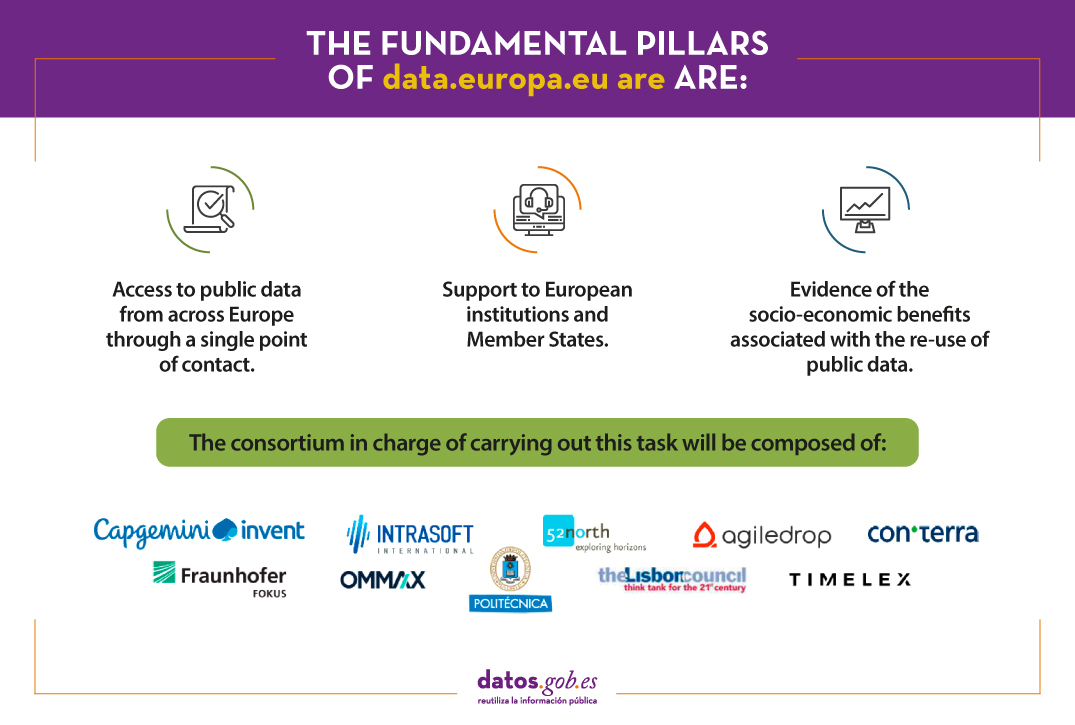
More information about the Ontological Engineering Group of the Universidad Politécnica de Madrid
The Ontological Engineering Group of the Polytechnic University of Madrid (OEG-UPM) is part of this project through a consortium led by Capgemini Invent, in collaboration with INTRASOFT International, and which also includes other organisations such as Fraunhofer FOKUS, OMMAX, con. terra, 52°North, agiledrop, Timelex, the Lisbon Council, the Universidad Politécnica de Madrid, CapGemini Idean and CapGemini Cybersecurity Services.
The OEG-UPM will work together with other consortium members on several of the studies related to the socio-economic impact of open data, the positioning of the future data.europa.eu in the context of the European Data Strategy, the future European Data Spaces and the European Open Science Cloud. It will also collaborate on the homogenisation of data in Europe to boost interoperability and on understanding the role that citizen-generated data can play in this context.
This Group has extensive experience in the area of open data. It leads the Madrid region node of the Open Data Institute and has collaborated in the design of the open data strategy, development and deployment of various open data infrastructures for several public administrations and non-profit organisations (e.g. the National Centre for Geographic Information, the National Library of Spain, the city of Zaragoza or the Regional Transport Consortium of Madrid). He has participated in the development of technical standards such as UNE 178301:2015 on Smart Cities and Open Data, or the series of technical reports and recommendations for the adoption of open data policies for the Spanish Federation of Municipalities and Provinces, among other actions.
This new contract with the EU is a great opportunity to give visibility to these and other actions in our country. As Oscar Corcho, who leads the team at the Universidad Politécnica de Madrid, says, "The work on this six-year contract will allow us to transfer some of our experiences to the future of open data in the European Union and its Member States".
Once again, the European Data Portal has just published its Open Data Maturity Report 2019, which measures the development achieved in the field of open data in Europe. And, as in previous years, Spain occupies the second position, which makes it a prescriber in terms of open data.
According to the report, the average of open data maturity of the EU28 is 66%, only one percentage point above the data obtained in 2018. In the case of Spain, the score obtained has been 90%, three points more than in 2018 and well above the European average. Only Ireland, with 91%, is ahead of Spain.

With this score, Spain is part of the so-called group of Trend setters, along with Ireland and France. The countries that belong to this group are characterized by having an advanced open data strategy and a strong commitment to open data as a strategic asset to drive digital transformation.
In 2018, this group was formed by five countries, but only three have remained in 2019. Spain, like the rest of European leaders, has had to improve its score to continue remaining in the leading group.
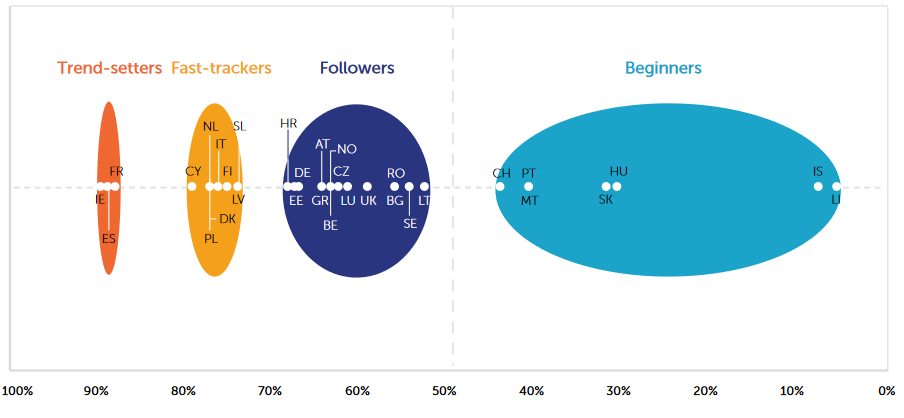
At a general level, the report highlights that Europe is entering a consolidation phase, where the focus has been shifted from quantity to quality of published data. Once policies and open data platforms are implemented, European countries are trying to ensure the value of the data by driving its reuse.
Spain is above the European average in the 4 indicators analyzed
To produce the report, the European Data Portal has analyzed 4 key indicators: policy, portal, impact and quality. The growth of Spain has been driven by the portal and impact dimensions, as seen below.

- The “political” dimension analyzes existing policies and strategies to promote open data at the national level, as well as the existence of governance models. Spain's score in this section is 90% -the EU is 74%-, although it has decreased compared to 2018. This is because, although there are specific policies to boost open data, there is still work to be done for its implementation
- The “portal” dimension has been the one that has experienced the greatest growth in the last year, going from 78% in 2018 to 89% in 2019. This dimension focuses on the level of maturity of national open data platforms. For this, it analyzes the functionality, the use (user analysis), the data variety and the approach used to guarantee the sustainability of the platform.
- The “impact” dimension, in which Spain has obtained the best score, assesses the existence of methodologies to monitor and measure the reuse and impact of open data. In this case, the score obtained has been 100%, with a growth of 3 points compared to 2018.
- Finally, the “quality” dimension, which explores the level of automation of European platforms, the accuracy and reliability of the available data and the level of compliance in terms of the DCAT-AP metadata standard, has remained virtually the same as last year: 77% in 2019 compared to 78% in 2018.
Recommendations for further progress on open data
As in previous editions, the report ends with a series of recommendations for all the countries analyzed. In the case of Trend setters, the group to which Spain belongs, the following conclusions are included, among others:
- Promote thematic data ecosystems around the thematic domains defined in the recent Directive on Open Data and the re-use of Public Sector Information.
- Boost data in real time.
- Continue the work on improving the quality of metadata and data by boosting the use of tools (for example, for the validation of metadata).
- Work with training institutions to provide advanced open data courses and training.
- Engage universities and research institutions to develop country-specific metrics to measure impact.
You can see the factsheet of Spain in this link and those of the rest of the countries here.